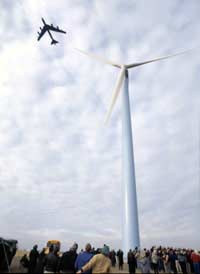The nation’s first wind-to-hydrogen production project will be up and running this week near Minot, Basin Electric Power Cooperative announced Tuesday.
The public is invited to its dedication at 2:30 p.m. Saturday at the North Dakota State University North Central Research Extension Center, a mile south of Minot.
Sen. Byron Dorgan, D-N.D., who helped secure much of the funding for the operation, will gas up a hydrogen-powered pickup to officially launch the plant, Basin spokesman Daryl Hill said.
hydrogen-powered pickup to officially launch the plant, Basin spokesman Daryl Hill said.
The $2 million research and development project has been in the works for three years, Hill said. The company is a lead partner among several entities involved, including NDSU’s extension service and the Energy and Environmental Research Center in Grand Forks.
It is designed to demonstrate that variable wind energy can be turned into an energy source that can be stored and used as needed, Basin’s announcement said.
The plant is in a small structure about the size of a shipping container, located on the grounds of the Minot research station. It consists of a hydrogen electrolyzer from Belgium, a storage tank that holds 80 kilograms of compressed hydrogen gas and a gas pump for filling vehicles.
A kilogram of compressed hydrogen gas is about equivalent to a gallon of gas, he said.
In its location at the Minot research station, it will power three Chevy Silverado pickups being used by the research station and Basin and Verendrye Electric Cooperative of Velva.
One pickup will be in Saturday’s State Fair parade in Minot, Hill said. A tractor for the research station is being converted to run on a diesel-hydrogen mix, he said, a project by the NDSU mechanical engineering department.
Hill said the pickups were converted from flex-fuel vehicles to tri-fuel vehicles by an Arizona company. That means the pickups can run on gasoline, an E-85 ethanol blend or hydrogen.
The wind energy will come from Basin Electric’s North Dakota wind towers near Minot, Edgeley-Kulm and Wilton. Though those towers feed electricity into the area power grid and not directly to the hydrogen plant, the plant is governed by a system that matches the plant’s electricity use exactly to the wind towers’ output, a system known as dynamic scheduling.
Primary partners besides Basin, the EERC and NDSU’s Minot research station were Verendrye Electric; Central Power Electric Cooperative, Minot and the National Rural Electric Cooperative Association’s Cooperative Research Network.

